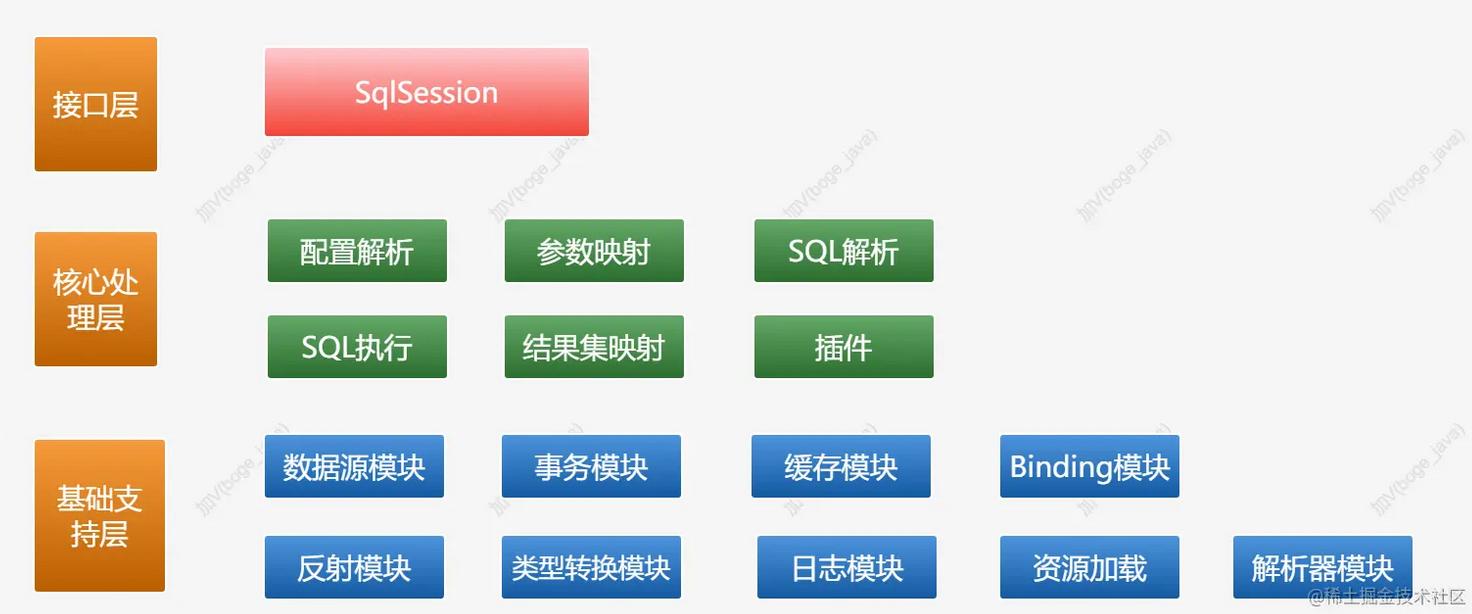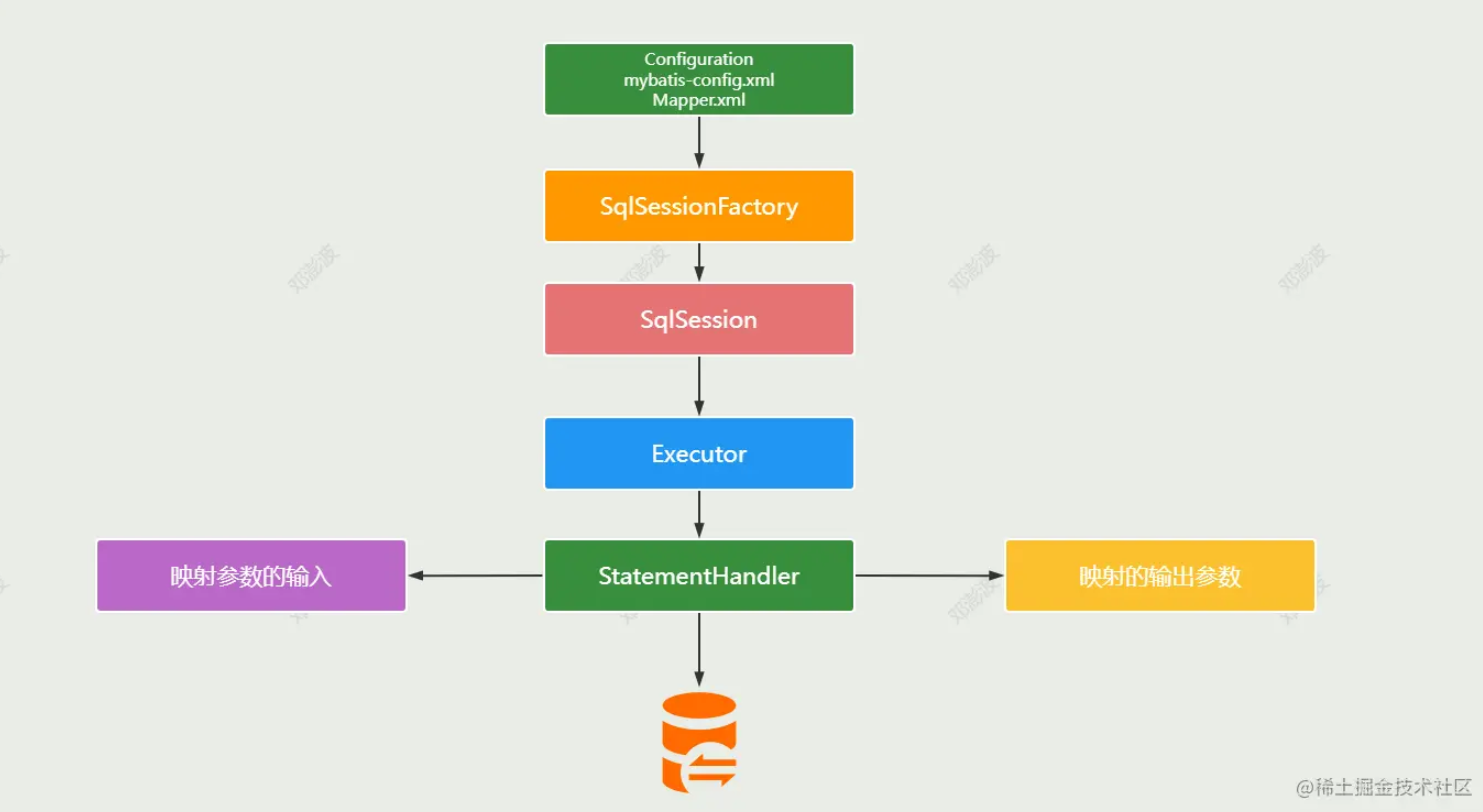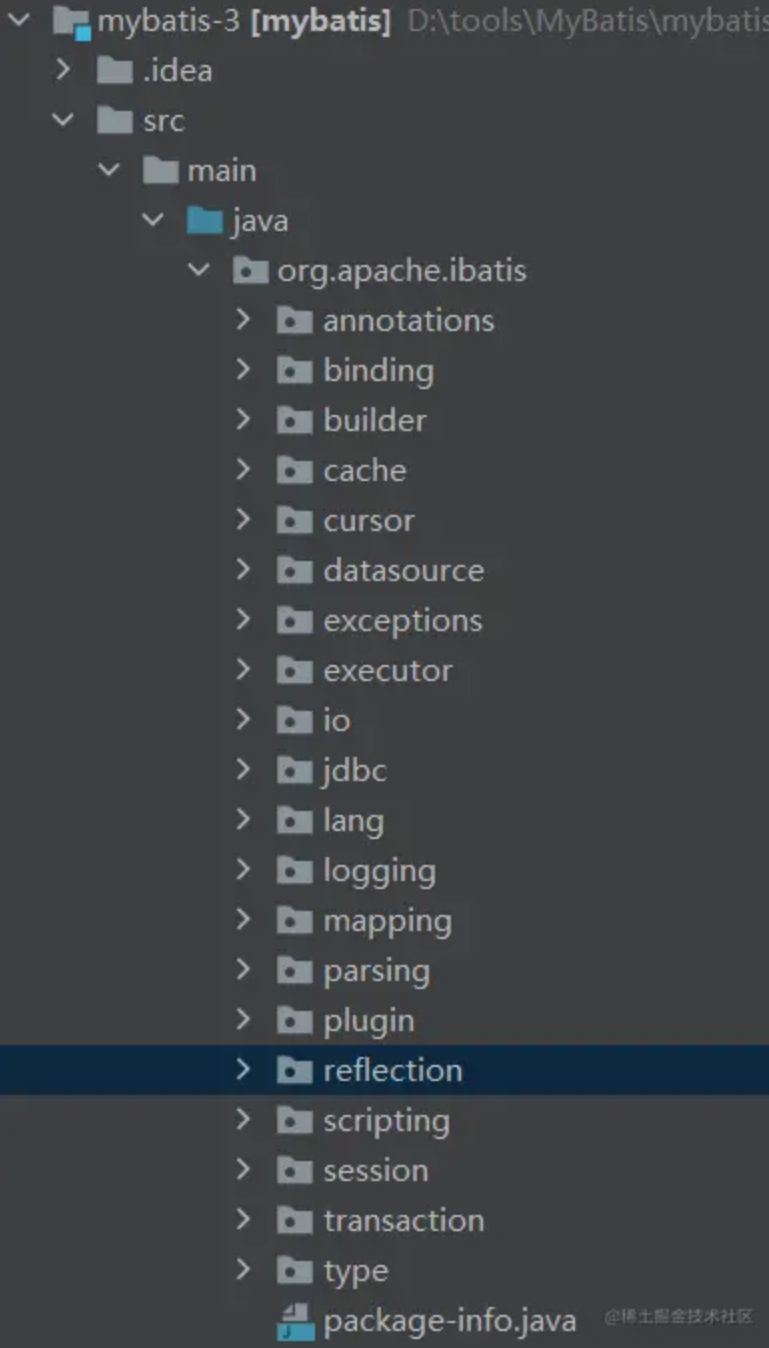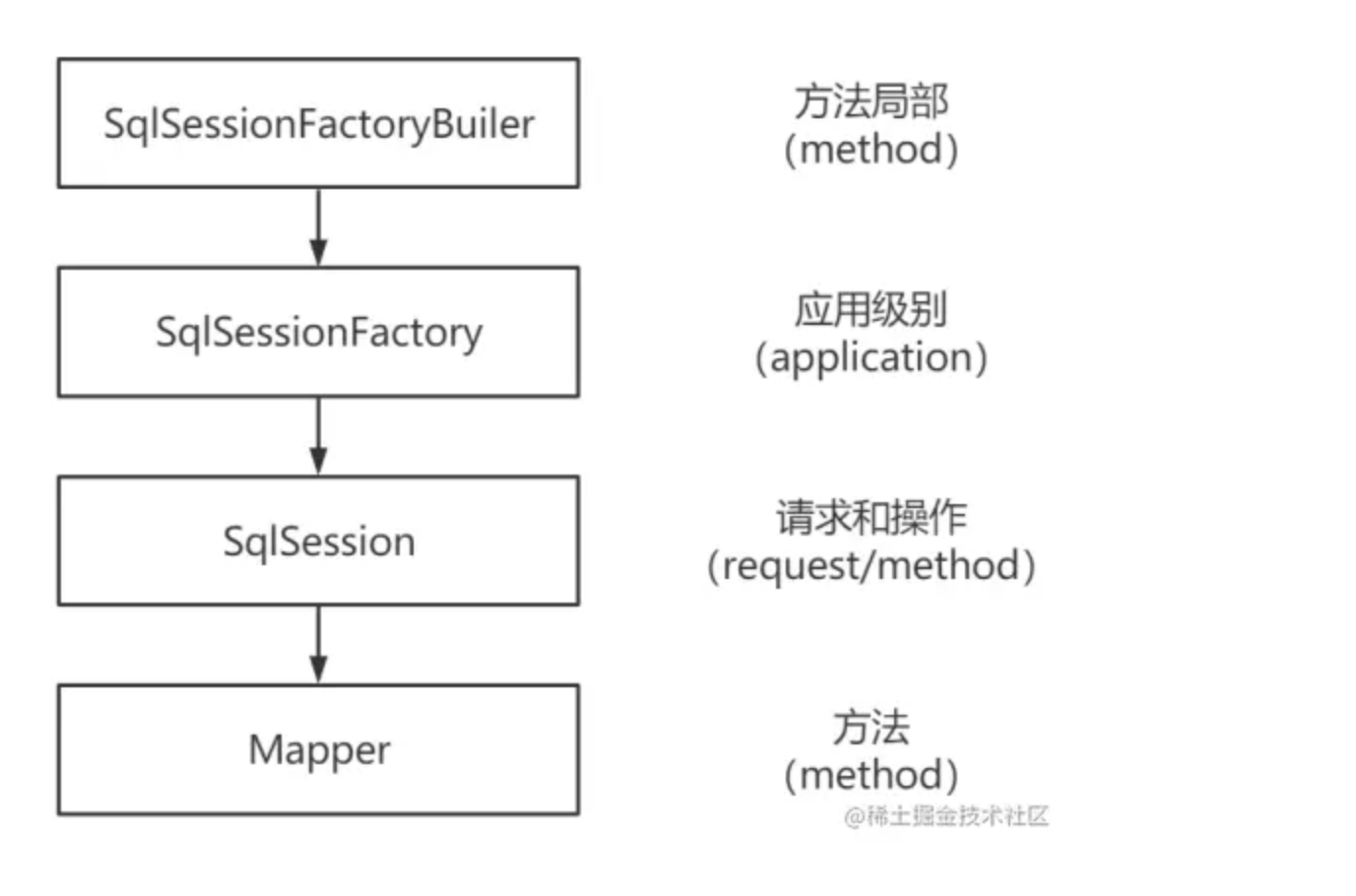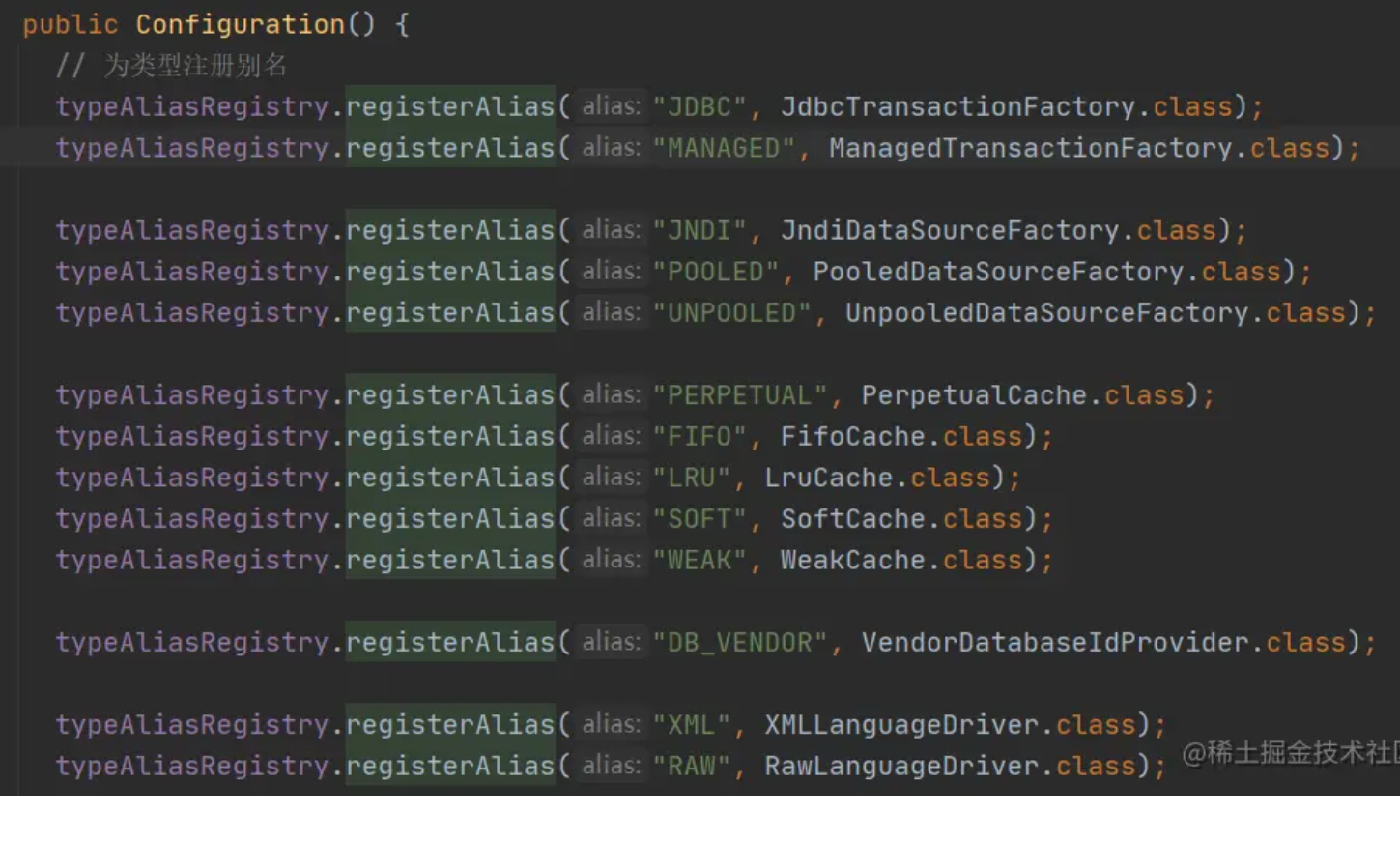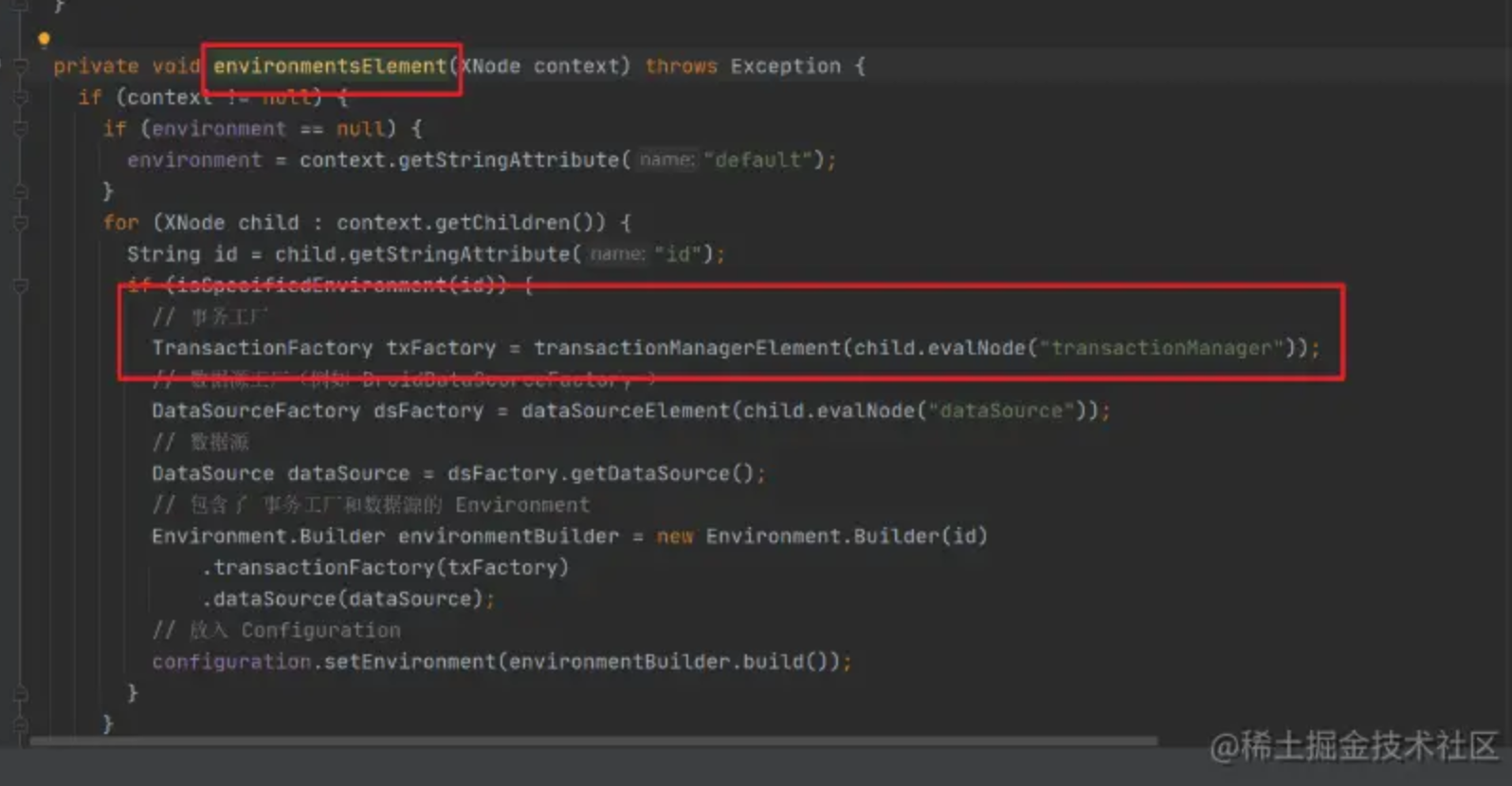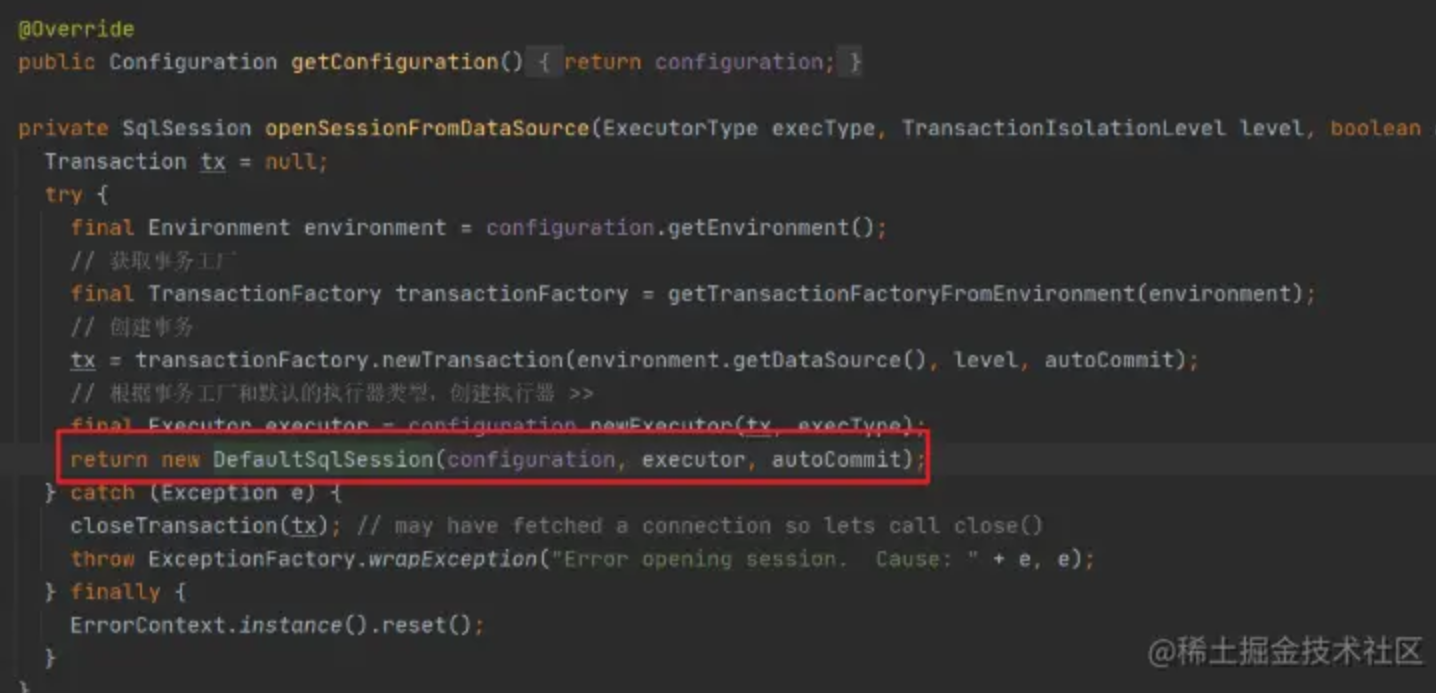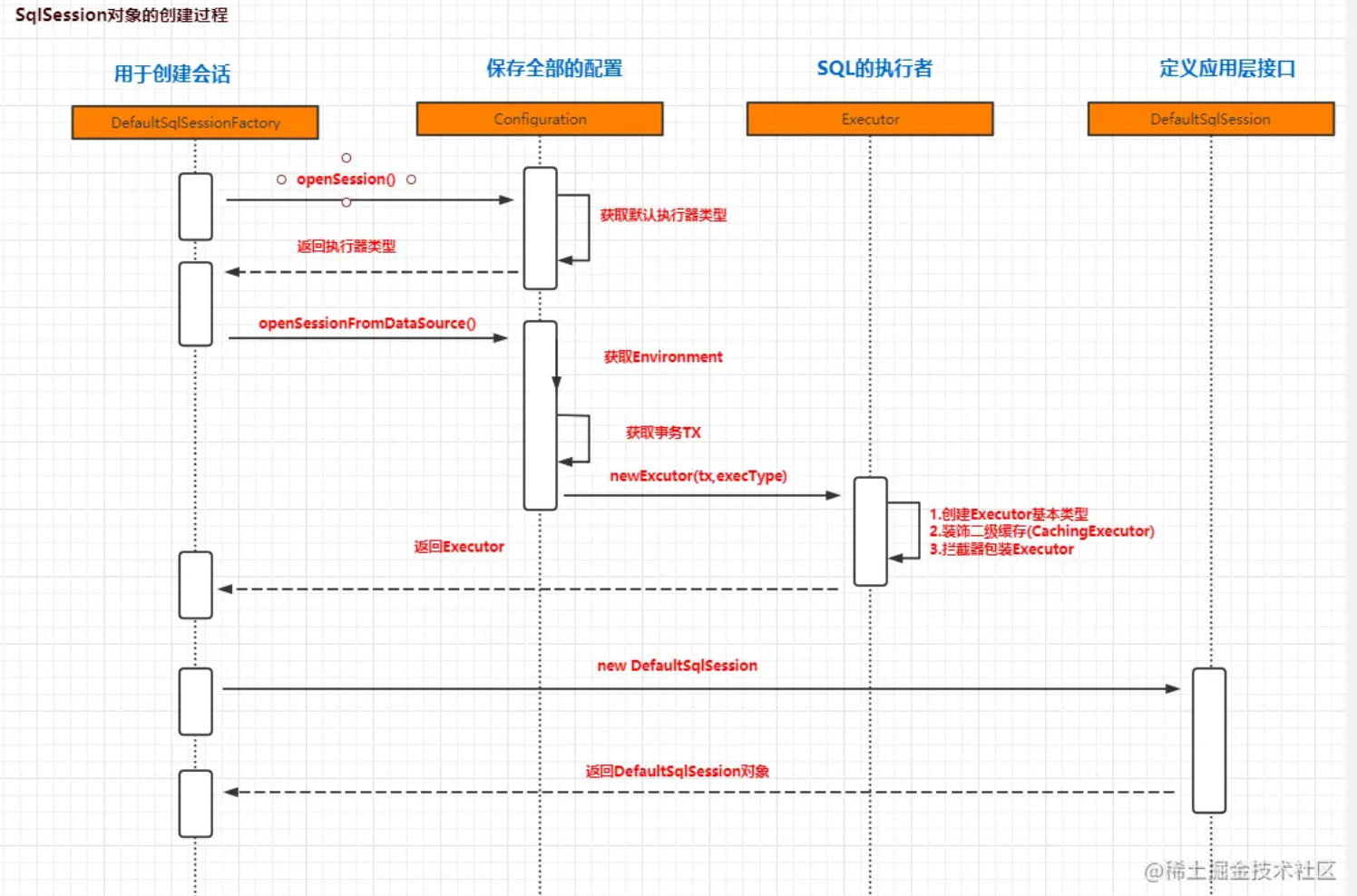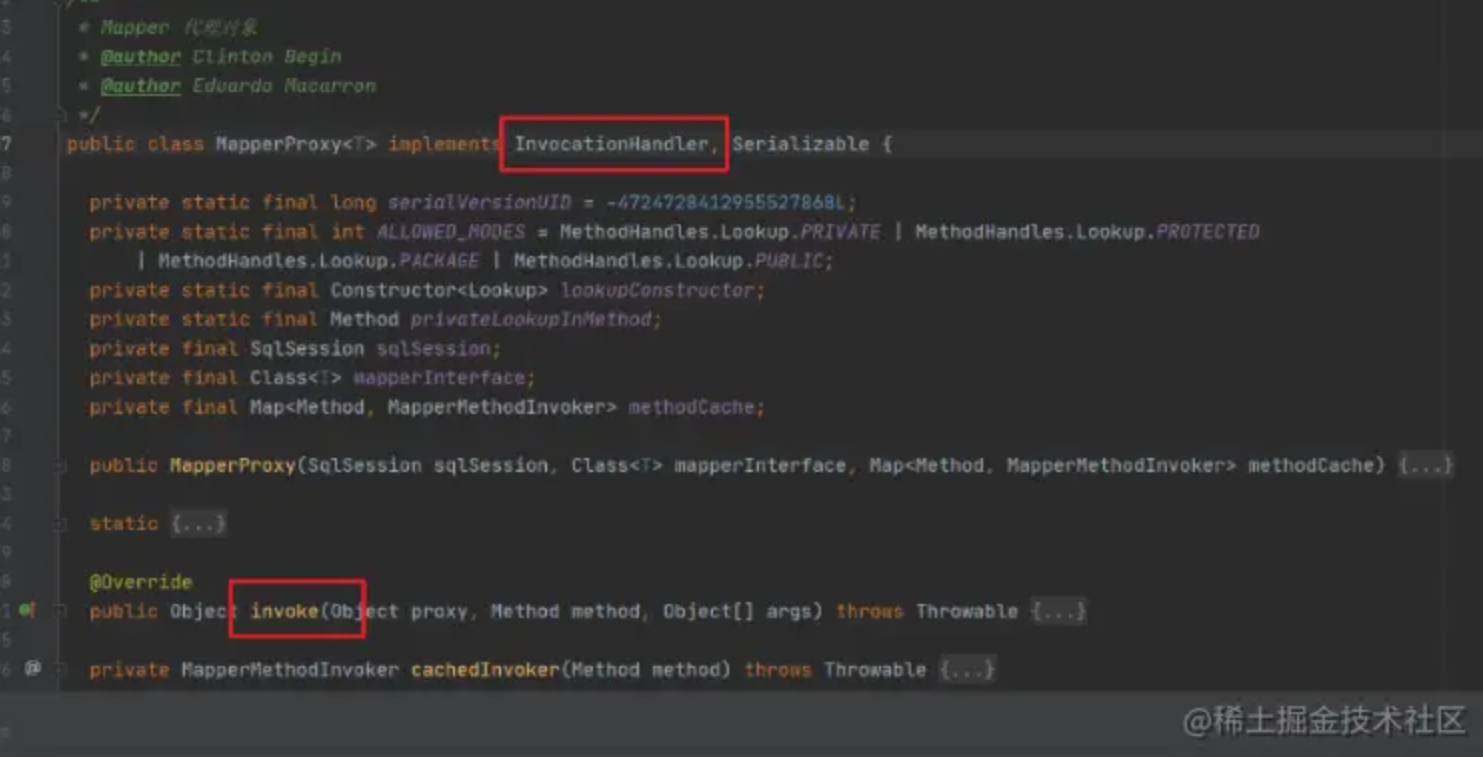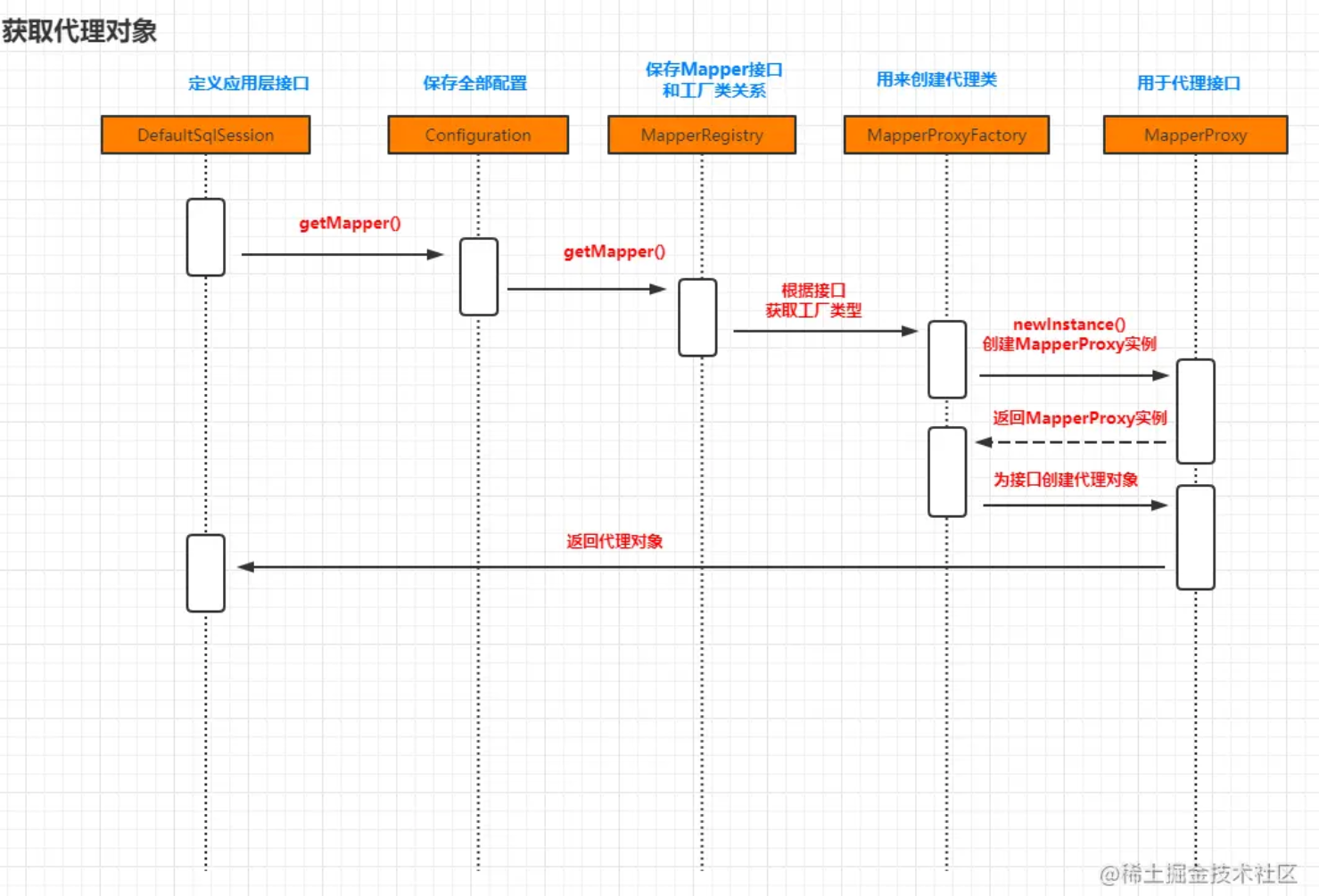一、MyBatis源码分析
1.三层划分介绍
接下来我们就开始MyBatis的源码之旅,首先大家要从宏观上了解Mybatis的整体框架分为三层,分别是基础支持层、核心处理层、和接口层。如下图
然后根据前面讲解的MyBatis的应用案例,给出MyBatis的主要工作流程图
在MyBatis的主要工作流程里面,不同的功能是由很多不同的类协作完成的,它们分布在MyBatis jar包的不同的package里面。
大概有一千多个类,这样看起来不够清楚,不知道什么类在什么环节工作,属于什么层次。MyBatis按照功能职责的不同,所有的package可以分成不同的工作层次。上面的那个图已经给大家展现了
1.1 接口层
首先接口层是我们打交道最多的。核心对象是SqlSession,它是上层应用和MyBatis打交道的桥梁,SqlSession上定义了非常多的对数据库的操作方法。接口层在接收到调用请求的时候,会调用核心处理层的相应模块来完成具体的数据库操作。 复制代码
1.2 核心处理层
接下来是核心处理层。既然叫核心处理层,也就是跟数据库操作相关的动作都是在这一层完成的。
核心处理层主要做了这几件事:
- 把接口中传入的参数解析并且映射成JDBC类型;
- 解析xml文件中的SQL语句,包括插入参数,和动态SQL的生成;
- 执行SQL语句;
- 处理结果集,并映射成Java对象。
插件也属于核心层,这是由它的工作方式和拦截的对象决定的。
1.3 基础支持层
最后一个就是基础支持层。基础支持层主要是一些抽取出来的通用的功能(实现复用),用来支持核心处理层的功能。比如数据源、缓存、日志、xml解析、反射、IO、事务等等这些功能, 复制代码
2. 核心流程
分析源码我们还是从编程式的Demo入手。Spring的集成后面会介绍 复制代码
/** * MyBatis getMapper 方法的使用 */ @Test public void test2() throws Exception{ // 1.获取配置文件 InputStream in = Resources.getResourceAsStream("mybatis-config.xml"); // 2.加载解析配置文件并获取SqlSessionFactory对象 SqlSessionFactory factory = new SqlSessionFactoryBuilder().build(in); // 3.根据SqlSessionFactory对象获取SqlSession对象 SqlSession sqlSession = factory.openSession(); // 4.通过SqlSession中提供的 API方法来操作数据库 UserMapper mapper = sqlSession.getMapper(UserMapper.class); List<User> list = mapper.selectUserList(); for (User user : list) { System.out.println(user); } // 5.关闭会话 sqlSession.close(); } 复制代码
上面我们通过一个比较复杂的步骤实现了MyBatis的数据库查询操作。下面我们会按照这5个步骤来分析MyBatis的运行原理 复制代码
看源码的注意事项
- 一定要带着问题去看,猜想验证。
- 不要只记忆流程,学编程风格,设计思想(他的代码为什么这么写?如果不这么写呢?包括接口的定义,类的职责,涉及模式的应用,高级语法等等)。
- 先抓重点,就像开车熟路,哪个地方限速,哪个地方变道,要走很多次。先走主干道,再去、覆盖分支小路。
- 记录核心流程和对象,总结层次、结构、关系,输出(图片或者待注释的源码)。
- 培养看源码的信心和感觉,从带着看到自己去看,看更多的源码。
- debug还是直接Ctrl+Alt+B跟方法?debug可以看到实际的值,比如到底是哪个实现类,value到底是什么。但是Ctrl+Alt+B不一定能走到真正的对象,比如有代理或者父类方法,或者多个实现的时候。熟悉流程之后,直接跟方法。
2.1 核心对象的生命周期
2.1.1 SqlSessionFactoryBuiler
首先是SqlSessionFactoryBuiler。它是用来构建SqlSessionFactory的,而SqlSessionFactory只需要一个,所以只要构建了这一个SqlSessionFactory,它的使命就完成了,也就没有存在的意义了。所以它的生命周期只存在于方法的局部。 复制代码
2.1.2 SqlSessionFactory
SqlSessionFactory是用来创建SqlSession的,每次应用程序访问数据库,都需要创建一个会话。因为我们一直有创建会话的需要,所以SqlSessionFactory应该存在于应用的整个生命周期中(作用域是应用作用域)。创建SqlSession只需要一个实例来做这件事就行了,否则会产生很多的混乱,和浪费资源。所以我们要采用单例模式。 复制代码
2.1.3 SqlSession
SqlSession是一个会话,因为它不是线程安全的,不能在线程间共享。所以我们在请求开始的时候创建一个SqlSession对象,在请求结束或者说方法执行完毕的时候要及时关闭它(一次请求或者操作中)。 复制代码
2.1.4 Mapper
Mapper(实际上是一个代理对象)是从SqlSession中获取的。 复制代码
UserMapper mapper = sqlSession.getMapper(UserMapper.class); 复制代码
它的作用是发送SQL来操作数据库的数据。它应该在一个SqlSession事务方法之内。
2.2 SqlSessionFactory
首先我们来看下SqlSessionFactory对象的获取 复制代码
SqlSessionFactory factory = new SqlSessionFactoryBuilder().build(in); 复制代码
2.2.1 SqlSessionFactoryBuilder
首先我们new了一个SqlSessionFactoryBuilder,这是建造者模式的运用(建造者模式用来创建复杂对象,而不需要关注内部细节,是一种封装的体现)。MyBatis中很多地方用到了建造者模式(名字以Builder结尾的类还有9个)。 复制代码
SqlSessionFactoryBuilder中用来创建SqlSessionFactory对象的方法是build(),build()方法有9个重载,可以用不同的方式来创建SqlSessionFactory对象。SqlSessionFactory对象默认是单例的。 复制代码
public SqlSessionFactory build(InputStream inputStream, String environment, Properties properties) { try { // 用于解析 mybatis-config.xml,同时创建了 Configuration 对象 >> XMLConfigBuilder parser = new XMLConfigBuilder(inputStream, environment, properties); // 解析XML,最终返回一个 DefaultSqlSessionFactory >> return build(parser.parse()); } catch (Exception e) { throw ExceptionFactory.wrapException("Error building SqlSession.", e); } finally { ErrorContext.instance().reset(); try { inputStream.close(); } catch (IOException e) { // Intentionally ignore. Prefer previous error. } } } 复制代码
在build方法中首先是创建了一个XMLConfigBuilder对象,XMLConfigBuilder是抽象类BaseBuilder的一个子类,专门用来解析全局配置文件,针对不同的构建目标还有其他的一些子类(关联到源码路径),比如: 复制代码
- XMLMapperBuilder:解析Mapper映射器
- XMLStatementBuilder:解析增删改查标签
- XMLScriptBuilder:解析动态SQL
然后是执行了 复制代码
build(parser.parse()); 复制代码
构建的代码,parser.parse()方法返回的是一个Configuration对象,build方法的如下
public SqlSessionFactory build(Configuration config) { return new DefaultSqlSessionFactory(config); } 复制代码
在这儿我们可以看到SessionFactory最终实现是DefaultSqlSessionFactory对象。
2.2.2 XMLConfigBuilder
然后我们再来看下XMLConfigBuilder初始化的时候做了哪些操作 复制代码
public XMLConfigBuilder(InputStream inputStream, String environment, Properties props) { // EntityResolver的实现类是XMLMapperEntityResolver 来完成配置文件的校验,根据对应的DTD文件来实现 this(new XPathParser(inputStream, true, props, new XMLMapperEntityResolver()), environment, props); } 复制代码
再去进入重载的构造方法中
private XMLConfigBuilder(XPathParser parser, String environment, Properties props) { super(new Configuration()); // 完成了Configuration的初始化 ErrorContext.instance().resource("SQL Mapper Configuration"); this.configuration.setVariables(props); // 设置对应的Properties属性 this.parsed = false; // 设置 是否解析的标志为 false this.environment = environment; // 初始化environment this.parser = parser; // 初始化 解析器 } 复制代码
2.2.3 Configuration
然后我们可以看下Configuration初始化做了什么操作
完成了类型别名的注册工作,通过上面的分析我们可以看到XMLConfigBuilder完成了XML文件的解析对应XPathParser和Configuration对象的初始化操作,然后我们再来看下parse方法到底是如何解析配置文件的
2.2.4 parse解析
parser.parse() 复制代码
进入具体的解析方法
public Configuration parse() { // 检查是否已经解析过了 if (parsed) { throw new BuilderException("Each XMLConfigBuilder can only be used once."); } parsed = true; // XPathParser,dom 和 SAX 都有用到 >> 开始解析 parseConfiguration(parser.evalNode("/configuration")); return configuration; } 复制代码
parseConfiguration方法
private void parseConfiguration(XNode root) { try { //issue #117 read properties first // 对于全局配置文件各种标签的解析 propertiesElement(root.evalNode("properties")); // 解析 settings 标签 Properties settings = settingsAsProperties(root.evalNode("settings")); // 读取文件 loadCustomVfs(settings); // 日志设置 loadCustomLogImpl(settings); // 类型别名 typeAliasesElement(root.evalNode("typeAliases")); // 插件 pluginElement(root.evalNode("plugins")); // 用于创建对象 objectFactoryElement(root.evalNode("objectFactory")); // 用于对对象进行加工 objectWrapperFactoryElement(root.evalNode("objectWrapperFactory")); // 反射工具箱 reflectorFactoryElement(root.evalNode("reflectorFactory")); // settings 子标签赋值,默认值就是在这里提供的 >> settingsElement(settings); // read it after objectFactory and objectWrapperFactory issue #631 // 创建了数据源 >> environmentsElement(root.evalNode("environments")); databaseIdProviderElement(root.evalNode("databaseIdProvider")); typeHandlerElement(root.evalNode("typeHandlers")); // 解析引用的Mapper映射器 mapperElement(root.evalNode("mappers")); } catch (Exception e) { throw new BuilderException("Error parsing SQL Mapper Configuration. Cause: " + e, e); } } 复制代码
2.2.4.1 全局配置文件解析
properties解析
private void propertiesElement(XNode context) throws Exception { if (context != null) { // 创建了一个 Properties 对象,后面可以用到 Properties defaults = context.getChildrenAsProperties(); String resource = context.getStringAttribute("resource"); String url = context.getStringAttribute("url"); if (resource != null && url != null) { // url 和 resource 不能同时存在 throw new BuilderException("The properties element cannot specify both a URL and a resource based property file reference. Please specify one or the other."); } // 加载resource或者url属性中指定的 properties 文件 if (resource != null) { defaults.putAll(Resources.getResourceAsProperties(resource)); } else if (url != null) { defaults.putAll(Resources.getUrlAsProperties(url)); } Properties vars = configuration.getVariables(); if (vars != null) { // 和 Configuration中的 variables 属性合并 defaults.putAll(vars); } // 更新对应的属性信息 parser.setVariables(defaults); configuration.setVariables(defaults); } } 复制代码
第一个是解析<properties>标签,读取我们引入的外部配置文件,例如db.properties。
这里面又有两种类型,一种是放在re
source目录下的,是相对路径,一种是写的绝对路径的(url)。
解析的最终结果就是我们会把所有的配置信息放到名为defaults的Properties对象里面(Hashtable对象,KV存储),最后把XPathParser和Configuration的Properties属性都设置成我们填充后的Properties对象。
settings解析
private Properties settingsAsProperties(XNode context) { if (context == null) { return new Properties(); } // 获取settings节点下的所有的子节点 Properties props = context.getChildrenAsProperties(); // Check that all settings are known to the configuration class MetaClass metaConfig = MetaClass.forClass(Configuration.class, localReflectorFactory); for (Object key : props.keySet()) { // if (!metaConfig.hasSetter(String.valueOf(key))) { throw new BuilderException("The setting " + key + " is not known. Make sure you spelled it correctly (case sensitive)."); } } return props; } 复制代码
getChildrenAsProperties方法就是具体的解析了
public Properties getChildrenAsProperties() { Properties properties = new Properties(); for (XNode child : getChildren()) { // 获取对应的name和value属性 String name = child.getStringAttribute("name"); String value = child.getStringAttribute("value"); if (name != null && value != null) { properties.setProperty(name, value); } } return properties; } 复制代码
loadCustomVfs(settings)方法
loadCustomVfs是获取Vitual File System的自定义实现类,比如要读取本地文件,或者FTP远程文件的时候,就可以用到自定义的VFS类。 复制代码
根据<settings>标签里面的<vfsImpl>标签,生成了一个抽象类VFS的子类,在MyBatis中有JBoss6VFS和DefaultVFS两个实现,在io包中。
private void loadCustomVfs(Properties props) throws ClassNotFoundException { String value = props.getProperty("vfsImpl"); if (value != null) { String[] clazzes = value.split(","); for (String clazz : clazzes) { if (!clazz.isEmpty()) { @SuppressWarnings("unchecked") Class<? extends VFS> vfsImpl = (Class<? extends VFS>)Resources.classForName(clazz); configuration.setVfsImpl(vfsImpl); } } } } 复制代码
最后赋值到Configuration中。 复制代码
loadCustomLogImpl(settings)方法
loadCustomLogImpl是根据 复制代码
<logImpl>标签获取日志的实现类,我们可以用到很多的日志的方案,包括LOG4J,LOG4J2,SLF4J等等,在logging包中。
private void loadCustomLogImpl(Properties props) { Class<? extends Log> logImpl = resolveClass(props.getProperty("logImpl")); configuration.setLogImpl(logImpl); } 复制代码
typeAliases解析
这一步是类型别名的解析 复制代码
private void typeAliasesElement(XNode parent) { // 放入 TypeAliasRegistry if (parent != null) { for (XNode child : parent.getChildren()) { if ("package".equals(child.getName())) { String typeAliasPackage = child.getStringAttribute("name"); configuration.getTypeAliasRegistry().registerAliases(typeAliasPackage); } else { String alias = child.getStringAttribute("alias"); String type = child.getStringAttribute("type"); try { Class<?> clazz = Resources.classForName(type); if (alias == null) { // 扫描 @Alias 注解使用 typeAliasRegistry.registerAlias(clazz); } else { // 直接注册 typeAliasRegistry.registerAlias(alias, clazz); } } catch (ClassNotFoundException e) { throw new BuilderException("Error registering typeAlias for '" + alias + "'. Cause: " + e, e); } } } } } 复制代码
plugins解析
插件标签的解析 复制代码
private void pluginElement(XNode parent) throws Exception { if (parent != null) { for (XNode child : parent.getChildren()) { // 获取<plugin> 节点的 interceptor 属性的值 String interceptor = child.getStringAttribute("interceptor"); // 获取<plugin> 下的所有的properties子节点 Properties properties = child.getChildrenAsProperties(); // 获取 Interceptor 对象 Interceptor interceptorInstance = (Interceptor) resolveClass(interceptor).getDeclaredConstructor().newInstance(); // 设置 interceptor的 属性 interceptorInstance.setProperties(properties); // Configuration中记录 Interceptor configuration.addInterceptor(interceptorInstance); } } } 复制代码
插件的具体使用后面专门介绍
objectFactory,objectWrapperFactory及reflectorFactory解析
private void objectFactoryElement(XNode context) throws Exception { if (context != null) { // 获取<objectFactory> 节点的 type 属性 String type = context.getStringAttribute("type"); // 获取 <objectFactory> 节点下的配置信息 Properties properties = context.getChildrenAsProperties(); // 获取ObjectFactory 对象的对象 通过反射方式 ObjectFactory factory = (ObjectFactory) resolveClass(type).getDeclaredConstructor().newInstance(); // ObjectFactory 和 对应的属性信息关联 factory.setProperties(properties); // 将创建的ObjectFactory对象绑定到Configuration中 configuration.setObjectFactory(factory); } } private void objectWrapperFactoryElement(XNode context) throws Exception { if (context != null) { String type = context.getStringAttribute("type"); ObjectWrapperFactory factory = (ObjectWrapperFactory) resolveClass(type).getDeclaredConstructor().newInstance(); configuration.setObjectWrapperFactory(factory); } } private void reflectorFactoryElement(XNode context) throws Exception { if (context != null) { String type = context.getStringAttribute("type"); ReflectorFactory factory = (ReflectorFactory) resolveClass(type).getDeclaredConstructor().newInstance(); configuration.setReflectorFactory(factory); } } 复制代码
ObjectFactory用来创建返回的对象。
ObjectWrapperFactory用来对对象做特殊的处理。比如:select没有写别名,查询返回的是一个Map,可以在自定义的objectWrapperFactory中把下划线命名变成驼峰命名。
ReflectorFactory是反射的工具箱,对反射的操作进行了封装(官网和文档没有这个对象的描述)。
以上四个对象,都是用resolveClass创建的。
settingsElement(settings)方法
这里就是对<settings>标签里面所有子标签的处理了,前面我们已经把子标签全部转换成了Properties对象,所以在这里处理Properties对象就可以了。
settings二级标签中一共26个配置,比如二级缓存、延迟加载、默认执行器类型等等。
需要注意的是,我们之前提到的所有的默认值,都是在这里赋值的。如果说后面我们不知道这个属性的值是什么,也可以到这一步来确认一下。
所有的值,都会赋值到Configuration的属性里面去。
private void settingsElement(Properties props) { configuration.setAutoMappingBehavior(AutoMappingBehavior.valueOf(props.getProperty("autoMappingBehavior", "PARTIAL"))); configuration.setAutoMappingUnknownColumnBehavior(AutoMappingUnknownColumnBehavior.valueOf(props.getProperty("autoMappingUnknownColumnBehavior", "NONE"))); configuration.setCacheEnabled(booleanValueOf(props.getProperty("cacheEnabled"), true)); configuration.setProxyFactory((ProxyFactory) createInstance(props.getProperty("proxyFactory"))); configuration.setLazyLoadingEnabled(booleanValueOf(props.getProperty("lazyLoadingEnabled"), false)); configuration.setAggressiveLazyLoading(booleanValueOf(props.getProperty("aggressiveLazyLoading"), false)); configuration.setMultipleResultSetsEnabled(booleanValueOf(props.getProperty("multipleResultSetsEnabled"), true)); configuration.setUseColumnLabel(booleanValueOf(props.getProperty("useColumnLabel"), true)); configuration.setUseGeneratedKeys(booleanValueOf(props.getProperty("useGeneratedKeys"), false)); configuration.setDefaultExecutorType(ExecutorType.valueOf(props.getProperty("defaultExecutorType", "SIMPLE"))); configuration.setDefaultStatementTimeout(integerValueOf(props.getProperty("defaultStatementTimeout"), null)); configuration.setDefaultFetchSize(integerValueOf(props.getProperty("defaultFetchSize"), null)); configuration.setDefaultResultSetType(resolveResultSetType(props.getProperty("defaultResultSetType"))); configuration.setMapUnderscoreToCamelCase(booleanValueOf(props.getProperty("mapUnderscoreToCamelCase"), false)); configuration.setSafeRowBoundsEnabled(booleanValueOf(props.getProperty("safeRowBoundsEnabled"), false)); configuration.setLocalCacheScope(LocalCacheScope.valueOf(props.getProperty("localCacheScope", "SESSION"))); configuration.setJdbcTypeForNull(JdbcType.valueOf(props.getProperty("jdbcTypeForNull", "OTHER"))); configuration.setLazyLoadTriggerMethods(stringSetValueOf(props.getProperty("lazyLoadTriggerMethods"), "equals,clone,hashCode,toString")); configuration.setSafeResultHandlerEnabled(booleanValueOf(props.getProperty("safeResultHandlerEnabled"), true)); configuration.setDefaultScriptingLanguage(resolveClass(props.getProperty("defaultScriptingLanguage"))); configuration.setDefaultEnumTypeHandler(resolveClass(props.getProperty("defaultEnumTypeHandler"))); configuration.setCallSettersOnNulls(booleanValueOf(props.getProperty("callSettersOnNulls"), false)); configuration.setUseActualParamName(booleanValueOf(props.getProperty("useActualParamName"), true)); configuration.setReturnInstanceForEmptyRow(booleanValueOf(props.getProperty("returnInstanceForEmptyRow"), false)); configuration.setLogPrefix(props.getProperty("logPrefix")); configuration.setConfigurationFactory(resolveClass(props.getProperty("configurationFactory"))); } 复制代码
environments解析
这一步是解析<environments>标签。
我们前面讲过,一个environment就是对应一个数据源,所以在这里我们会根据配置的<transactionManager>创建一个事务工厂,根据<dataSource>标签创建一个数据源,最后把这两个对象设置成Environment对象的属性,放到Configuration里面。
private void environmentsElement(XNode context) throws Exception { if (context != null) { if (environment == null) { environment = context.getStringAttribute("default"); } for (XNode child : context.getChildren()) { String id = child.getStringAttribute("id"); if (isSpecifiedEnvironment(id)) { // 事务工厂 TransactionFactory txFactory = transactionManagerElement(child.evalNode("transactionManager")); // 数据源工厂(例如 DruidDataSourceFactory ) DataSourceFactory dsFactory = dataSourceElement(child.evalNode("dataSource")); // 数据源 DataSource dataSource = dsFactory.getDataSource(); // 包含了 事务工厂和数据源的 Environment Environment.Builder environmentBuilder = new Environment.Builder(id) .transactionFactory(txFactory) .dataSource(dataSource); // 放入 Configuration configuration.setEnvironment(environmentBuilder.build()); } } } } 复制代码
databaseIdProviderElement()
解析databaseIdProvider标签,生成DatabaseIdProvider对象(用来支持不同厂商的数据库)。
typeHandlerElement()
跟TypeAlias一样,TypeHandler有两种配置方式,一种是单独配置一个类,一种是指定一个package。最后我们得到的是JavaType和JdbcType,以及用来做相互映射的TypeHandler之间的映射关系,存放在TypeHandlerRegistry对象里面。
private void typeHandlerElement(XNode parent) { if (parent != null) { for (XNode child : parent.getChildren()) { if ("package".equals(child.getName())) { String typeHandlerPackage = child.getStringAttribute("name"); typeHandlerRegistry.register(typeHandlerPackage); } else { String javaTypeName = child.getStringAttribute("javaType"); String jdbcTypeName = child.getStringAttribute("jdbcType"); String handlerTypeName = child.getStringAttribute("handler"); Class<?> javaTypeClass = resolveClass(javaTypeName); JdbcType jdbcType = resolveJdbcType(jdbcTypeName); Class<?> typeHandlerClass = resolveClass(handlerTypeName); if (javaTypeClass != null) { if (jdbcType == null) { typeHandlerRegistry.register(javaTypeClass, typeHandlerClass); } else { typeHandlerRegistry.register(javaTypeClass, jdbcType, typeHandlerClass); } } else { typeHandlerRegistry.register(typeHandlerClass); } } } } } 复制代码
mapper解析
最后就是<mappers>标签的解析。
根据全局配置文件中不同的注册方式,用不同的方式扫描,但最终都是做了两件事情,对于语句的注册和接口的注册。
| 扫描类型 | 含义 |
| resource | 相对路径 |
| url | 绝对路径 |
| package | 包 |
| class | 单个接口 |
private void mapperElement(XNode parent) throws Exception { if (parent != null) { for (XNode child : parent.getChildren()) { // 不同的定义方式的扫描,最终都是调用 addMapper()方法(添加到 MapperRegistry)。这个方法和 getMapper() 对应 // package 包 if ("package".equals(child.getName())) { String mapperPackage = child.getStringAttribute("name"); configuration.addMappers(mapperPackage); } else { String resource = child.getStringAttribute("resource"); String url = child.getStringAttribute("url"); String mapperClass = child.getStringAttribute("class"); if (resource != null && url == null && mapperClass == null) { // resource 相对路径 ErrorContext.instance().resource(resource); InputStream inputStream = Resources.getResourceAsStream(resource); XMLMapperBuilder mapperParser = new XMLMapperBuilder(inputStream, configuration, resource, configuration.getSqlFragments()); // 解析 Mapper.xml,总体上做了两件事情 >> mapperParser.parse(); } else if (resource == null && url != null && mapperClass == null) { // url 绝对路径 ErrorContext.instance().resource(url); InputStream inputStream = Resources.getUrlAsStream(url); XMLMapperBuilder mapperParser = new XMLMapperBuilder(inputStream, configuration, url, configuration.getSqlFragments()); mapperParser.parse(); } else if (resource == null && url == null && mapperClass != null) { // class 单个接口 Class<?> mapperInterface = Resources.classForName(mapperClass); configuration.addMapper(mapperInterface); } else { throw new BuilderException("A mapper element may only specify a url, resource or class, but not more than one."); } } } } } 复制代码
然后开始进入具体的配置文件的解析操作
2.2.4.2 映射文件的解析
首先进入parse方法 复制代码
public void parse() { // 总体上做了两件事情,对于语句的注册和接口的注册 if (!configuration.isResourceLoaded(resource)) { // 1、具体增删改查标签的解析。 // 一个标签一个MappedStatement。 >> configurationElement(parser.evalNode("/mapper")); configuration.addLoadedResource(resource); // 2、把namespace(接口类型)和工厂类绑定起来,放到一个map。 // 一个namespace 一个 MapperProxyFactory >> bindMapperForNamespace(); } parsePendingResultMaps(); parsePendingCacheRefs(); parsePendingStatements(); } 复制代码
configurationElement()——解析所有的子标签,最终获得MappedStatement对象。
bindMapperForNamespace()——把namespace(接口类型)和工厂类MapperProxyFactory绑定起来。
configurationElement方法
configurationElement是对Mapper.xml中所有具体的标签的解析,包括namespace、cache、parameterMap、resultMap、sql和select|insert|update|delete。 复制代码
private void configurationElement(XNode context) { try { String namespace = context.getStringAttribute("namespace"); if (namespace == null || namespace.equals("")) { throw new BuilderException("Mapper's namespace cannot be empty"); } builderAssistant.setCurrentNamespace(namespace); // 添加缓存对象 cacheRefElement(context.evalNode("cache-ref")); // 解析 cache 属性,添加缓存对象 cacheElement(context.evalNode("cache")); // 创建 ParameterMapping 对象 parameterMapElement(context.evalNodes("/mapper/parameterMap")); // 创建 List<ResultMapping> resultMapElements(context.evalNodes("/mapper/resultMap")); // 解析可以复用的SQL sqlElement(context.evalNodes("/mapper/sql")); // 解析增删改查标签,得到 MappedStatement >> buildStatementFromContext(context.evalNodes("select|insert|update|delete")); } catch (Exception e) { throw new BuilderException("Error parsing Mapper XML. The XML location is '" + resource + "'. Cause: " + e, e); } } 复制代码
在buildStatementFromContext()方法中,创建了用来解析增删改查标签的XMLStatementBuilder,并且把创建的MappedStatement添加到mappedStatements中。
MappedStatement statement = statementBuilder.build(); // 最关键的一步,在 Configuration 添加了 MappedStatement >> configuration.addMappedStatement(statement); 复制代码
bindMapperForNamespace方法
private void bindMapperForNamespace() { String namespace = builderAssistant.getCurrentNamespace(); if (namespace != null) { Class<?> boundType = null; try { // 根据名称空间加载对应的接口类型 boundType = Resources.classForName(namespace); } catch (ClassNotFoundException e) { //ignore, bound type is not required } if (boundType != null) { if (!configuration.hasMapper(boundType)) { // Spring may not know the real resource name so we set a flag // to prevent loading again this resource from the mapper interface // look at MapperAnnotationBuilder#loadXmlResource configuration.addLoadedResource("namespace:" + namespace); // 添加到 MapperRegistry,本质是一个 map,里面也有 Configuration >> configuration.addMapper(boundType); } } } } 复制代码
通过源码分析发现主要是是调用了addMapper()。addMapper()方法中,把接口类型注册到MapperRegistry中:实际上是为接口创建一个对应的MapperProxyFactory(用于为这个type提供工厂类,创建MapperProxy)。 复制代码
public <T> void addMapper(Class<T> type) { if (type.isInterface()) { // 检测 type 是否为接口 if (hasMapper(type)) { // 检测是否已经加装过该接口 throw new BindingException("Type " + type + " is already known to the MapperRegistry."); } boolean loadCompleted = false; try { // !Map<Class<?>, MapperProxyFactory<?>> 存放的是接口类型,和对应的工厂类的关系 knownMappers.put(type, new MapperProxyFactory<>(type)); // It's important that the type is added before the parser is run // otherwise the binding may automatically be attempted by the // mapper parser. If the type is already known, it won't try. // 注册了接口之后,根据接口,开始解析所有方法上的注解,例如 @Select >> MapperAnnotationBuilder parser = new MapperAnnotationBuilder(config, type); parser.parse(); loadCompleted = true; } finally { if (!loadCompleted) { knownMappers.remove(type); } } } } 复制代码
同样的再进入parse方法中查看
public void parse() { String resource = type.toString(); if (!configuration.isResourceLoaded(resource)) { // 先判断 Mapper.xml 有没有解析,没有的话先解析 Mapper.xml(例如定义 package 方式) loadXmlResource(); configuration.addLoadedResource(resource); assistant.setCurrentNamespace(type.getName()); // 处理 @CacheNamespace parseCache(); // 处理 @CacheNamespaceRef parseCacheRef(); // 获取所有方法 Method[] methods = type.getMethods(); for (Method method : methods) { try { // issue #237 if (!method.isBridge()) { // 解析方法上的注解,添加到 MappedStatement 集合中 >> parseStatement(method); } } catch (IncompleteElementException e) { configuration.addIncompleteMethod(new MethodResolver(this, method)); } } } parsePendingMethods(); } 复制代码
大家可以继续进入到parseStatement方法中查看。
总结:
- 我们主要完成了config配置文件、Mapper文件、Mapper接口中注解的解析。
- 我们得到了一个最重要的对象Configuration,这里面存放了全部的配置信息,它在属性里面还有各种各样的容器。
- 最后,返回了一个DefaultSqlSessionFactory,里面持有了Configuration的实例。
最后的时序图
2.3 SqlSession
程序每一次操作数据库,都需要创建一个会话,我们用openSession()方法来创建。接下来我们看看SqlSession创建过程中做了哪些操作 复制代码
SqlSession sqlSession = factory.openSession(); 复制代码
通过前面创建的DefaultSqlSessionFactory的openSession方法来创建 复制代码
@Override public SqlSession openSession() { return openSessionFromDataSource(configuration.getDefaultExecutorType(), null, false); } 复制代码
首先会获取默认的执行器类型。默认的是simple
继续往下
private SqlSession openSessionFromDataSource(ExecutorType execType, TransactionIsolationLevel level, boolean autoCommit) { Transaction tx = null; try { final Environment environment = configuration.getEnvironment(); // 获取事务工厂 final TransactionFactory transactionFactory = getTransactionFactoryFromEnvironment(environment); // 创建事务 tx = transactionFactory.newTransaction(environment.getDataSource(), level, autoCommit); // 根据事务工厂和默认的执行器类型,创建执行器 >> final Executor executor = configuration.newExecutor(tx, execType); return new DefaultSqlSession(configuration, executor, autoCommit); } catch (Exception e) { closeTransaction(tx); // may have fetched a connection so lets call close() throw ExceptionFactory.wrapException("Error opening session. Cause: " + e, e); } finally { ErrorContext.instance().reset(); } } 复制代码
我们在解析environment标签的时候有创建TransactionFactory对象
根据事务工厂和默认的执行器类型,创建执行器
public Executor newExecutor(Transaction transaction, ExecutorType executorType) { executorType = executorType == null ? defaultExecutorType : executorType; executorType = executorType == null ? ExecutorType.SIMPLE : executorType; Executor executor; if (ExecutorType.BATCH == executorType) { executor = new BatchExecutor(this, transaction); } else if (ExecutorType.REUSE == executorType) { executor = new ReuseExecutor(this, transaction); } else { // 默认 SimpleExecutor executor = new SimpleExecutor(this, transaction); } // 二级缓存开关,settings 中的 cacheEnabled 默认是 true if (cacheEnabled) { executor = new CachingExecutor(executor); } // 植入插件的逻辑,至此,四大对象已经全部拦截完毕 executor = (Executor) interceptorChain.pluginAll(executor); return executor; } 复制代码
最后返回的是一个DefaultSqlSession对象
在这个DefaultSqlSession对象中包括了Configuration和Executor对象
总结:创建会话的过程,我们获得了一个DefaultSqlSession,里面包含了一个Executor,Executor是SQL的实际执行对象。
2.4 Mapper代理对象
接下来看下通过getMapper方法获取对应的接口的代理对象的实现原理 复制代码
// 4.通过SqlSession中提供的 API方法来操作数据库 UserMapper mapper = sqlSession.getMapper(UserMapper.class); 复制代码
进入DefaultSqlSession中查看
public <T> T getMapper(Class<T> type, SqlSession sqlSession) { // mapperRegistry中注册的有Mapper的相关信息 在解析映射文件时 调用过addMapper方法 return mapperRegistry.getMapper(type, sqlSession); } 复制代码
进入getMapper方法
/** * 获取Mapper接口对应的代理对象 */ public <T> T getMapper(Class<T> type, SqlSession sqlSession) { // 获取Mapper接口对应的 MapperProxyFactory 对象 final MapperProxyFactory<T> mapperProxyFactory = (MapperProxyFactory<T>) knownMappers.get(type); if (mapperProxyFactory == null) { throw new BindingException("Type " + type + " is not known to the MapperRegistry."); } try { return mapperProxyFactory.newInstance(sqlSession); } catch (Exception e) { throw new BindingException("Error getting mapper instance. Cause: " + e, e); } } 复制代码
进入newInstance方法
public T newInstance(SqlSession sqlSession) { final MapperProxy<T> mapperProxy = new MapperProxy<>(sqlSession, mapperInterface, methodCache); return newInstance(mapperProxy); } 复制代码
继续
/** * 创建实现了 mapperInterface 接口的代理对象 */ protected T newInstance(MapperProxy<T> mapperProxy) { // 1:类加载器:2:被代理类实现的接口、3:实现了 InvocationHandler 的触发管理类 return (T) Proxy.newProxyInstance(mapperInterface.getClassLoader(), new Class[] { mapperInterface }, mapperProxy); } 复制代码
最终我们在代码中发现代理对象是通过JDK动态代理创建,返回的代理对象。而且里面也传递了一个实现了InvocationHandler接口的触发管理类。
总结:获得Mapper对象的过程,实质上是获取了一个JDK动态代理对象(类型是$ProxyN)。这个代理类会继承Proxy类,实现被代理的接口,里面持有了一个MapperProxy类型的触发管理类。
